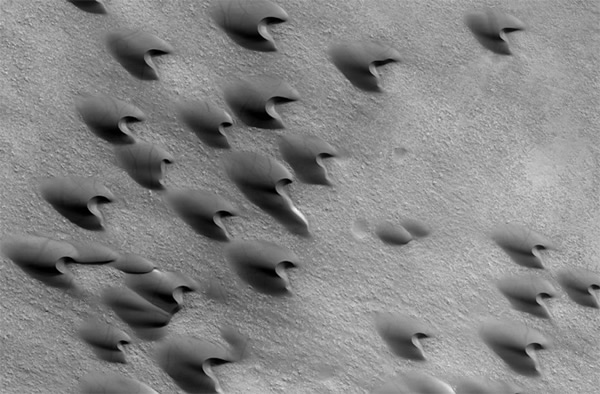Sand Dunes Could Reveal Weather on Alien Worlds
Barchan dunes inside Arkhangelsky Crater in the southern hemisphere of Mars as seen by the High-Resolution Imaging Science Experiment (HiRISE) camera on NASA's Mars Reconnaissance Orbiter (MRO). This photo reveals that the dunes are aligning to a wind direction from top left to bottom right, but seasonal shifts in prevailing wind could also be presence. Note the tracks of Martian dust devils over the dune slopes.
Tracking weather conditions on other planets is no easy task, but if we start playing close attention to dune formation, we could develop a means to at least know which way the wind is blowing.
In research published in the journal Nature Geoscience on Sunday, the work of Clément Narteau of the Global Institute for Physics in Paris and his team is discussed. In 2008, Clément bulldozed 160,000 square meters (16 hectares) of sand dunes in the Tengger desert of Inner Mongolia. Then, over the next three and a half years, the researchers watched how the desert winds re-formed the dunes, revealing information about the prevailing winds.
As noted by New Scientist, the researchers tracked two seasonal prevailing winds that both contributed to the dunes’ shapes and orientation. The dunes’ orientation turned into a “compromise” between the two different prevailing wind directions, strength and duration.
Although this research may sound very terrestrial, there are applications that go far beyond our planet.
“Our landscape-scale experiment suggests that the alignment of aeolian dunes can be used to determine wind forcing patterns on the Earth and other planetary bodies,” writes Clément.
For example, Mars and the Saturnian moon Titan are known to possess vast dune fields, shaped by persistent wind-shaping (aeolian) processes. Already, planetary scientists use Mars’ beautiful barchan dunes to glean information about prevailing wind direction on the red planet’s surface.
But, as this research shows, two prevailing winds contribute to a dune direction compromise. This means that although we may see a very definite orientation in Mars dunes, it doesn’t necessarily mean there is only one prevailing wind — there could be seasonal shifts too.(Jan 13, 2014 12:25 PM ET // by Ian O'Neill)












